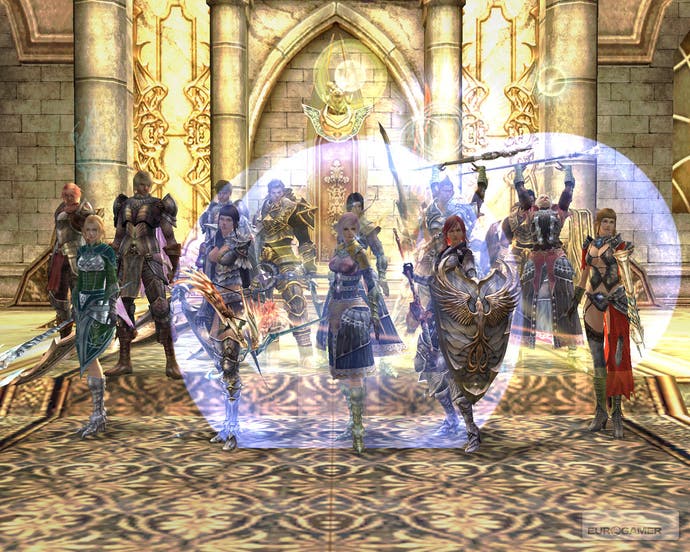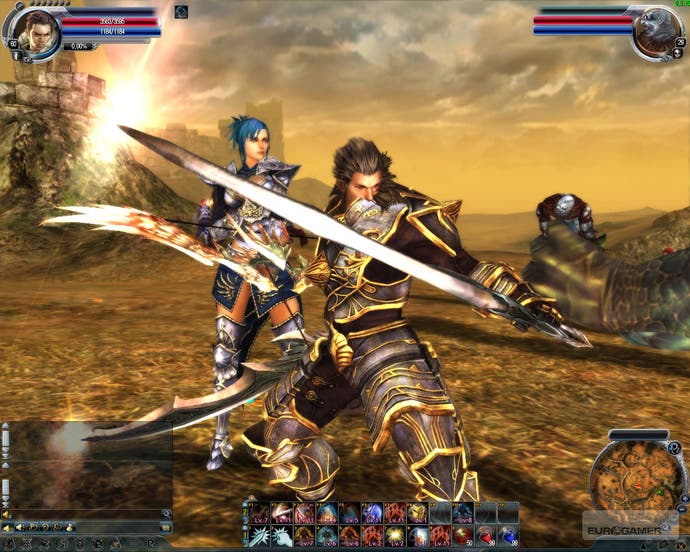Pristontale 2: The Second Enigma
No such thing as a free lunch.
You're not likely to have heard of Pristontale before, as the MMORPG originated in Korea seven years ago, before being translated into English in 2004. The game won accolades in its native language, and prompted a green light for developer Yedang Online to work on a big-budget sequel, which was released in April this year across Korea and found 40,000 players. Pristontale 2 heads West in November, but not without a little help: behind the wheel is Key To Play, a newly-formed online portal that hand-picked the MMO as its launch title in Europe.
Key To Play has gone to a lot of effort: both on an elaborate launch event in Barcelona featuring a live introduction to the story of God demon Midranda and his desire to destroy the world, and the content of the MMO itself. Key To Play understands that Korean design doesn't necessarily translate here, and holds "cultural localisation" at the heart of its operation. The online portal has worked with Yedang Online to bring more story elements and Western character design into Pristontale 2.
But the biggest selling point of the game will be that there's no cost involved in downloading or playing it; the only charge in Pristontale 2 is for microtransactions later on. Which, incidentally, we weren't shown.

What we did see were the main attractions: a combo battle system where skills can be chained together; exotic mounts, such as trolls whose shoulders you can ride; open player-versus-player combat; and all the fun - or misery - that comes from grouping with other human beings. That's what we were shown. Our experience was rather different.
It began choosing a race, which was between the warrior Tempskron or the magical Morion. We picked Tempskron and decided on the male Fighter over the female Huntress, mostly because he grunted when we moused over him. Fighters can branch out and become Warriors or Combatants at level 10, before picking Violent, Warlord or Destroyer paths later on. After choosing our class we changed our look in a fairly limited, but nicely varied, character creator.
The first problem we faced upon entering the world was knowing what to do. Clearly there was no new-age 'lead you by the hand' design here. Eventually we stumbled into a quest-giver, got our first task, and felt at home enough with the familiar user interface to set about chopping up some mushroom men. Mission accomplished, we jogged back into the city, got our reward, bagged more quests and headed out again. And again. And so began our arduous night of slaughtering giant bunnies, wolves, armadillos, pixies and hunchbacks, then running back into to town to pick up more quests and do the same thing all over again.

We got some new skills along the way, plus some slightly less tattered armour, but once resting between fights was added to the repetitive battles and monotonous slogs back to town, we began to lose hope. And all of this at just level 9 - one more level and we could have picked a profession, maybe a craft, and perhaps used one of those unexplained NPCs to make something. But we simply couldn't face it. And why should we? Let alone settle for 60 levels of it.
We understand MMOs lead you into the meat of the game slowly in order for abilities and features to be grasped, but this was quite clearly design cast from the mould of old. It was oblivious to recent advancements in the genre, introduced to ease - rather than rely on - the grind to flesh out content.
Much of the high-level content demonstrated in Barcelona offered little more; the zones were barren and vast, with a mish-mash of uninspired monster types ambling aimlessly around as if waiting for someone to pick a fight with them. It could have been the starting area all over again, just with bigger statistics involved. If grouping was the star feature on show, we saw none of the teamwork expected of instances in World of Warcraft, and the player-versus-player combat petered out after the combatants proved too equally matched to make a dent on each other and decided to call it quits. Of all the features displayed, only the spunky combo system provided any real glimpse of differentiation.

But then, comparisons to World of Warcraft and Warhammer Online are perhaps unfair. Pristontale 2, lest we forget, is free. And, much to its credit, such parallels are only drawn in the first place because the game is technically very accomplished. The world is solid, the combat fluid and lively, the graphics crisp and clear, and the music dramatic and atmospheric. The overall presentation is uncluttered and coherent, and it happened to run very nicely on a mid-range PC (although the total population of four at the time probably played its part there).
Pristontale 2 is only in closed beta, but already the production values of a game with an experienced MMO developer behind it are plain to see. Those prepared to pour the hours in will have plenty to discover. The world lacks the instant personality and depth seen elsewhere in the genre, but Pristontale 2 is certainly a technical stride forward for the free-to-play crowd, and a game only the harshest of criticisms would warrant the curious not trying.
And try you can by bagging one of a limited number of closed beta keys from our Pristontale 2 giveaway. Open beta is due to start in November, with the full launch to follow later that month.

